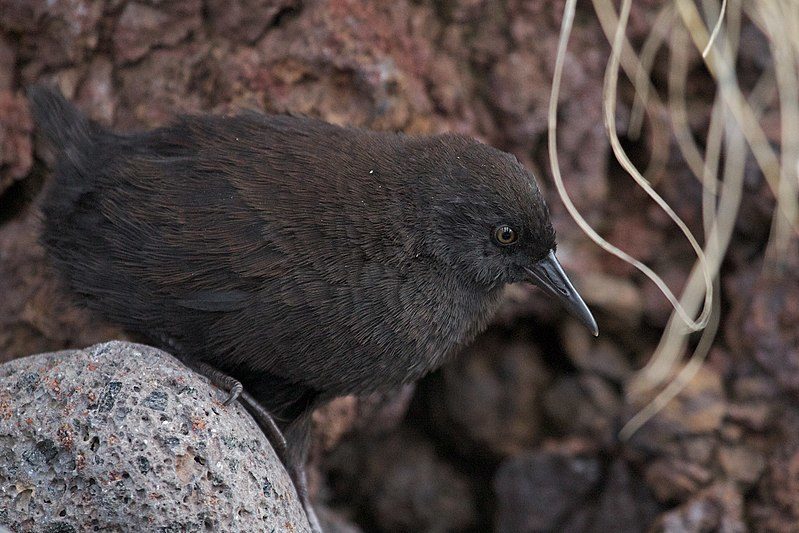
Inaccessible Island Rail Facts
- The attention-grabbing term of Inaccessible Island Rail serves as the most frequently used name for a remarkable bird. For the moment, it does not possess any other broadly used general title. While that’s not unknown, it’s somewhat uncommon.
- Among scientific professionals, however, it’s typically better known by its formal name. Like many such appellations, though, that’s relatively difficult for the layperson to pronounce. That’s because it holds the technical moniker of Laterallus rogersi.
- It received that formal title due to the efforts of the British physician and ornithologist, Percy Lowe. He accomplished the first official recognition of the animal as a separate and distinct species. That scientifically noteworthy action occurred in 1923.
- A scientific expedition to the island noted the bird roughly 50 years before, but no formal study took place. Indigenous Peoples of other islands long visited the site to hunt seals prior to this date, but it’s unknown if they ever noted the remarkable avian.
- Unfortunately, the fabulous Inaccessible Island Rail finds itself in relatively dire straits. It has a steady population, but only a limited range. Due to that limited territory, along with other factors, the IUCN presently lists this species as Vulnerable on its Red List
- Currently, it enjoys a reasonable security, since tightly limited access to its location prevents the introduction of non-native species. Yet it remains especially vulnerable to the danger of climate change due to the nature of its specific situation.
Related Articles
Inaccessible Island Rail Physical Description
The extraordinary Inaccessible Island Rail immediately captures the attention of those few fortunate enough to visit it. Yet it does so not simply because of its unique appearance. It also merits notice given the fact that it’s one of only 60 known flightless birds.
Perhaps the most notable thing about the wonderful creation of evolutionary processes is simply its physical size. That’s because, overall, the fascinating species attains an average body length only measuring approximately 5.1 – 6.1 in (13 – 15.5 cm).
Thus it earns its impressive status as the smallest bird of its kind presently known to man. But, like many birds, the tiny wonder also displays a moderate degree of sexual dimorphism. In the case of this particular species, that presents itself in terms of body mass.
More precisely, the males attain a greater average weight than their female counterparts. These reach masses typically ranging from 1.2 – 1.7 oz (35 – 49 gms). Females, however, generally weigh 1.2 – 1.5 oz (34 – 42 gms). So the difference remains relatively minor.
The Inaccessible Island Rail also displays an appealing color scheme. Individuals typically present a chestnut-brown on the upper body, with dark gray on the head on lower regions. Nature did not simply stop there, though, when providing it a visual appeal.
This biological marvel also possesses scattered small streaks of white on the stomach and flanks. While present, its wings obviously remain too small for flight. Its tail evolved as comparatively short, as well. The eyes also stand out, displaying a brilliant shade of red.
- Kingdom: Animalia
- Phylum: Chordata
- Class: Aves
- Order: Gruiformes
- Family: Rallidae
- Genus: Atlantisia
- Species: A. rogersi
Inaccessible Island Rail Distribution, Habitat, and Ecology
The truly remarkable Inaccessible Island Rail inhabits an extremely restricted range. The nature of that location is suggested by its name, of course. But the precise location of that zone of habitation might surprise many people who learn of the amazing bird.
That’s because this bird only inhabits the tiny island its name derived from, Inaccessible Island. This itself forms part of the Tristan da Cunha group, located in the South Atlantic Ocean region. It’s roughly 19 mi (31 km) from the main island of the arcgipelago.
Although the extremely small island remains uninhabited by man, it makes an excellent home for this species. The interesting animal also proves itself to be highly adaptable, at least within its native range. Nature thus provided it with an evolutionary advantage.
This fact holds true because it lives in almost all the various habitat types found on the island. But its greatest population density occurs in regions of native tussock grass, mixed with sedges and ferns. It also has a preference for areas of pure tussock as well.
Yet, this wonderful fauna also lives in regions of both forest and heath. Impressively, this animal lives at all altitudes on the island, ranging from sea level up to 1,473 ft (449 m). There, the amazing Inaccessible Island Rail feeds as a technically omnivorous species.
While it does consume various berries and seeds occasionally, it primarily hunts live prey. This typically consists of amphipods, earthworms, mites, and a wide variety of local insects. However, it does not appear to feed on carrion, as some related species do.
Species Sharing Its Range
Check out our other articles on 5 Spellbinding Scorpions, Japanese Angelshark, Erta Ale, Apple-of-Peru, Seychelles Sheath-Tailed Bat, Socotra Bluet, Bee Hummingbird, Blue-lipped sea krait
